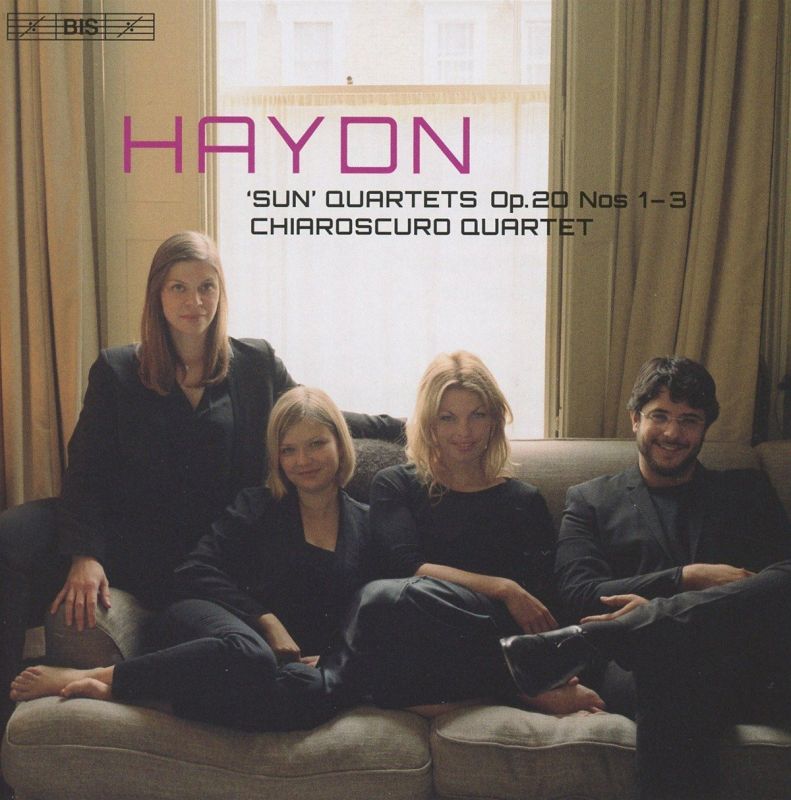HAYDN Sun Quartets Op 20 Nos 1 - 3
View record and artist detailsRecord and Artist Details
Composer or Director: Joseph Haydn
Genre:
Chamber
Label: BIS
Magazine Review Date: AW16
Media Format: Super Audio CD
Media Runtime: 74
Mastering:
DDD
Catalogue Number: BIS2158

Tracks:
| Composition | Artist Credit |
|---|---|
| (6) String Quartets (Divertimentos), 'Sun', Movement: E flat |
Joseph Haydn, Composer
Chiaroscuro Joseph Haydn, Composer |
| (6) String Quartets (Divertimentos), 'Sun', Movement: C |
Joseph Haydn, Composer
Chiaroscuro Joseph Haydn, Composer |
| (6) String Quartets (Divertimentos), 'Sun', Movement: G minor |
Joseph Haydn, Composer
Chiaroscuro Joseph Haydn, Composer |
Author: Richard Wigmore
If you prefer modern instruments in these essential Haydn works, go for The Lindsays (ASV, 6/98, 7/99) and the more subjectively inflected Doric (Chandos, 12/14). But recordings by the Mosaïques and the London Haydn quartets and now the Chiaroscuro make a compelling case for gut strings and lighter, Classical bows. To over-simplify, the Mosaïques are closest in their phrasing and use of vibrato to a modern-style performance, the London Haydn Quartet have a unique breadth and inwardness, while the Chiaroscuro tend to be fleeter and ‘straighter’ than either. For all their elegance and subtlety of timing, they slightly short-change the pre-Romantic sentiment in the glorious Poco adagio of No 3. They lose something, too, in their brisk traversals of the opening movements of Nos 1 (where the London Haydn Quartet’s spaciousness and gentle flexibility seem spot-on) and 2.
There are, though, many rewards elsewhere. Finales are especially good, whether in the airy, scherzando grace the Chiaroscuro bring to No 2’s fugue or the new, whimsical nuances when they repeat each half of the teasing finale of No 1. And their quizzical rather than driven approach to the finale of No 3, with pauses unpredictably timed, allies it with the first movement, where the Chiaroscuro play up the music’s disruptive, destabilising aspects. Memorable, too, are their fine line-drawing and acute response to the ebb and flow of harmonic tension in No 1’s Affetuoso e sostenuto (repeats, as ever, imaginatively rethought), and their shaping and colouring of the paired middle movements of No 2. In the latter the musette-minuet emerges dazed and weightless into the light after the disintegrating close of the C minor Capriccio – an exquisite moment and a reminder that sensitive gradations of piano, pianissimo and even (at the enigmatic close of No 3) ppp are among the chief strengths of these thoughtful, fine-grained performances.
Discover the world's largest classical music catalogue with Presto Music.

Gramophone Digital Club
- Digital Edition
- Digital Archive
- Reviews Database
- Full website access
From £8.75 / month
Subscribe
Gramophone Full Club
- Print Edition
- Digital Edition
- Digital Archive
- Reviews Database
- Full website access
From £11.00 / month
Subscribe
If you are a library, university or other organisation that would be interested in an institutional subscription to Gramophone please click here for further information.




